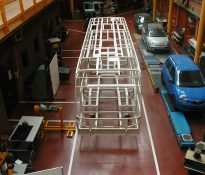Jan 25 2010
One of the accidents in which a bus can be involved is bus rollover. In these cases, the body structure is essential for the protection of the passengers, and the scientists analyze how to improve the structure's behavior when dealing with an event of this kind. Along these lines, the study carried out by the researchers from the UC3M Instituto de Seguridad de los Vehículos Automóviles (Automobile Safety Institute) (ISVA) proposes a mathematic model to estimate the vibration frequencies of the bus structure itself.
What is remarkable about it, according to one of the authors of the study, Antonio Gauchía, from the UC3M Mechanical Engineering Department, is its simplicity: "There are other numerical techniques such as the finite element method, to determine the vibration's own frequency, but this model allows it to be done in a faster and simpler fashion."
 Bus structure
Bus structure
The idea behind this research arose from the need to improve the behavior of bus body structure, and especially to increase the torsional rigidity, "In some vehicles headlights that break because they are not rigid enough have been observed", according to Professor Gauchía. "Moreover", he continued, "it has been observed that this factor is particularly relevant in the increase of the rollover threshold, and that as such, results in greater vehicle safety. Several factors are involved in obtaining a resistant rigid torsion structure, such as the dimensions of the cross-section of the profiles that make up the structure, the material of the profiles and the availability of the same in the bus structure.
Real applications.
"This research study, as well as others that we are carrying out along these same lines, have direct application in the bus sector, since they not only improve safety but also evolve from the idea of an oversized structure to a body structure somewhat smaller in design, in which variables such as weight, consumption, torsional rigidity, etc., are taken into account", explained the ISVA Director, UC3M Full Professor Vicente Díaz, one of the authors of the study, which was recently published in the International Journal of Heavy Vehicle Systems.
In driving conditions, vehicle rollover depends on a parameter (known as "rollover threshold") which is determined by the lateral acceleration from which the vehicle initiates the process. In this way, the larger the parameter, the greater the lateral acceleration that the vehicle would have to be subject to in order to make it roll over, thus, making the vehicle safer. "A body structure with high torsional rigidity increases the rollover limit and in addition offers a higher level of safety," Gauchía pointed out. On the other hand, if the rollover occurs and the body structure hits the ground, it should be sufficiently resistant so as to protect the passengers. Concretely, the Reglamento de Ginebra (Geneva Regulation) R66 and la Directiva (Guideline) 2001/85/CE establish that the bus structure be sufficiently rigid so as to maintain a space inside the bus, termed the survival space, in which no object can enter or exit.